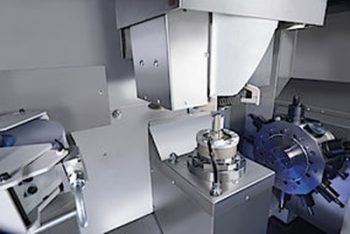
Photo by GmbH & Co. KG

Photo by GmbH & Co. KG
The EMAG Groups VLC series offers customers multifunctional machines that perform an array of hard machining processes on the transmission components in quick succession. The company, which is headquartered in Salach, Germany with its US location in Farmington Hills, MI specializes in turning and grinding, and has now added another important element to this portfolio, the new VLC 200 GT. This machine was developed by EMAG engineers especially for the chuck machining of automotive gears. Users benefit from not only highly efficient turning and grinding processes in a single clamping operation, but also by receiving excellent value for their money.
The automobile industry is going to to spend more money on research—annual increases of between seven and eight percent in this area have long since become standard. OEMs and suppliers in Germany alone recorded more than 34 billion euros in development expenses in the past year, according to a study by the German Association of the Automotive Industry or VDA (Verband der Automobilindustrie). One of the main focal points of this dynamic innovation is the transmission design. Today’s transmissions are generally becoming smaller (and therefore lighter), but can simultaneously offer more gear ratios and therefore have more gears and gearing components. This produces optimum speed ranges, and reduces fuel consumption. Each individual gear must be manufactured extremely quickly and very precisely. Given the high unit volumes, the production technology is virtually always a concern for production planners. They try to find solutions that reduce processing time and unit costs, while still continuing to increase the quality of the parts. The transmission specialists at EMAG have been meeting this challenge with success for decades. A notable quantum leap was achieved nearly 20 years ago when they developed the first pick-up machine for the combined turning and grinding machining of chucked parts. Its key feature was the intelligent combination of the two machining processes in rapid alternation, based on the shape of the workpiece and the quality required—a principle that the EMAG engineers have been continuously improving. With the VLC 200 GT, presented at last year’s AMB in Stuttgart, EMAG has introduced a new machine that ensures major advances in productivity, especially in the machining of automotive gears. Peter Loetzner, President & CEO of EMAG L.L.C., explained their approach: “The high unit volume and quality requirements of gears make them ideally suited to our approach. We now offer users a machine that is completely tailored to these components every detail.”
A short description of the process gives you some idea of the advances in productivity made possible by the VLC 200 GT. To begin with, the machine is loaded at exceptionally high speed by the integrated pick-up spindle, a classic EMAG feature. To minimize non-productive times, EMAG has optimized features such as the mechanism of the machining area door. Once the spindle with the part reaches its machining position, the process starts with hard pre-turning of the shoulder and the bore hole in quick succession. Only a few micrometers of material are then left to be removed from the gear. That means the subsequent grinding process, using either aluminum oxide or CBN grinding wheels, takes significantly less time. Meanwhile, the machining quality also benefits from the combination of turning and grinding: When there is only a small amount of material remaining to be ground away after turning, the specifications for the grinding wheel can be based more precisely on the end quality required—as a result, surfaces with an average peak-to-valley height Rz of less than 1.6 micrometers can be created reliably with the VLC 200 GT. In addition, this multifunctional technology offers users a multitude of possibilities generally: internal and external grinding spindles, scroll-free turning tools, block tool holders, and EMAG’s proven 12-station tool turret can all be installed as required.
There is an additional advantage in terms of tool costs, because while this process the grinding wheel wears down more slowly and therefore does not need to be dressed as often. When it does need dressing, the VLC 200 GT features a separate diamond-coated dressing roll designed specifically for this. “With its separate rotating dressing system and gap control monitoring, the machine is perfectly equipped to exploit the advantages of CBN grinding,” Loetzner said. To ensure sustained process reliability and high machining quality, the integrated measuring pin is used to check the diameter and length of the clamped component at the end of the process. Operator comfort and ease of access were important priorities for EMAG’s developers, so large doors allow easy access to the machining area. The tools and clamping devices are easily accessible and can be changed quickly and conveniently.
Even now, not long after the machine’s presentation at the AMB, the success story of the VLC 200 GT is taking shape: EMAG has received several pre-orders from OEMs and tier 1 suppliers. “This is an endorsement of our approach,” said Loetzner, who attributes this success in part to the machine’s small footprint and its ability to flexibly integrate into interlinked factory systems. The machine can be incorporated into a plant’s production system very well with the aid of a variety of automation systems. One option for this is the TrackMotion system. This automation system developed by EMAG handles transportation from machine to machine with functions such as part gripping, positioning, and flipping of the workpiece. “On the other hand, there is also the option of using the VLC 200 GT as a stand-alone machine with simple O-belt automation. This is an appealing alternative for many customers in the Asian markets especially,” Loetzner added. “This ultimately demonstrates the decisive advantage of this machine: We are offering producers of gears a custom-fit, flexible, highly productive solution with excellent value for money. That is inevitably going to win out in the marketplace.”
For more information visit: http://www.emag.com